
Forsythia, is a genus of flowering plants in the olive family Oleaceae. There are about 11 species, mostly native to eastern Asia, but one native to southeastern Europe. Forsythia – also one of the plant's common names – is named after William Forsyth.

The Garryales are a small order of dicotyledons, including only two families and three genera.

Lonicera japonica, known as Japanese honeysuckle and golden-and-silver honeysuckle, is a species of honeysuckle native to eastern Asia. It is often grown as an ornamental plant, but has become an invasive species in a number of countries. Japanese honeysuckle is used in traditional Chinese medicine.

Pieris is a genus of seven species of shrubs in the flowering plant family Ericaceae, native to mountain regions of eastern and southern Asia, eastern North America and Cuba. Known commonly in North America as andromedas or fetterbushes, they are broad-leaved evergreen shrubs growing to 1–6 metres tall and 3–10 ft (0.9–3.0 m) wide. The leaves are spirally arranged, often appearing to be in whorls at the end of each shoot with bare stretches of shoot below; they are lanceolate-ovate, 2–10 cm (0.8–3.9 in) long and 1.0–3.5 cm (0.4–1.4 in) broad, leathery textured, and with an entire or serrated margin. The young leaves in spring are typically brightly coloured. The flowers are bell-shaped, 5–15 mm (0.2–0.6 in) long, white or pink, and arranged in racemes 5–12 cm (2.0–4.7 in) long. The fruit is a woody capsule which splits into five sections to release the numerous small seeds.

Lespedeza is a genus of some 40 species of flowering plants in the pea family (Fabaceae), commonly known as bush clovers or Japanese clovers (hagi). The genus is native to warm temperate to subtropical regions of eastern North America, eastern and southern Asia and Australasia.
David Don was a Scottish botanist.

Inula is a genus of about 80 species of flowering plants in the family Asteraceae, native to Europe, Asia and Africa.

Weigela is a genus of between six and 38 species of deciduous shrubs in the family Caprifoliaceae, growing to 1–5 m (3–15′) tall. All are natives of eastern Asia. The genus is named after the German scientist Christian Ehrenfried Weigel.

Skimmia is a genus of four species of evergreen shrubs and small trees in the rue family Rutaceae, all native to warm temperate regions of Asia. The leaves are clustered at the ends of the shoots, simple, lanceolate, 6–21 cm long and 2–5 cm broad, with a smooth margin. The flowers are in dense panicle clusters, each flower small, 6–15 mm diameter, with 4-7 petals. The fruit is red to black, 6–12 mm diameter, a fleshy drupe containing a single seed. All parts of the plant have a pungent aroma when crushed. The botanical name Skimmia is a Latinization of shikimi, which is the Japanese name for Illicium religiosum as well as an element in miyama shikimi, the Japanese name for Skimmia japonica.

Chaenomeles japonica, called the Japanese quince or Maule's quince, is a species of flowering quince that is native to Japan.

Causonis japonica is the type species of vine plant in its genus and is native to Tropical and Subtropical Asia, Australia and the West Pacific. It is used as a traditional Chinese medicine to relieve swelling and heat, and to enhance diuresis and detoxification.

Ixeris is a genus of Asian flowering plants in the family Asteraceae.

Orixa japonica, commonly called East Asian orixa or Japanese orixa, is a deciduous shrub growing to 3 metres (10 ft) with an equal spread. Native to Japan and South Korea, it is found on forested, sunny slopes at elevations from 500 to 1300 m. A recent scientific study found this plant to contain previously unknown alkaloids that may be effective against Plasmodium falciparum, one of the protozoan species that cause human malaria.

Barnardia is a small genus of bulbous flowering plants in the family Asparagaceae, subfamily Scilloideae. The genus has two species, one found in the Balearic Islands and north-west Africa, the other in east China, Korea, Japan and adjacent localities. It was suggested in 2012 that the two species were not closely related.
This is an alphabetical list of useful timber trees, indigenous and exotic, growing in the Gauteng area of South Africa. These trees range in size up to some 1.5m DBH, such as Cedrus deodara, the Himalayan Cedar. Hobbyists will seek out even small pieces of highly valued timber, such as Buxus macowanii, the South African counterpart of Buxus sempervirens, for turnery or the making of boxes and small items. Despite the wealth of useful woods available in Gauteng, most of the trees, felled or fallen, are dumped or cut into short lengths for fuel. Trees grown in urban or suburban environments are rarely pruned and are consequently often knotty. Timber frequently holds nails, wire and spikes, attesting to a variety of abuse during the lifetime of a tree, and requiring the use of a metal detector by the sawmiller. Garden cuttings and dead leaves are occasionally piled next to trees and burnt, leaving charred scars and inclusions.

Eriocapitella is a genus of flowering plants in the buttercup family Ranunculaceae. Plants of the genus are native to Asia. The generic name Eriocapitella roughly translates to "growing in a small woolly head", which refers to the hairy ovary and fruit of some members of the genus. Cultivated plants are commonly known as fall-blooming anemones.

Eriocapitella japonica is a species of flowering plant in the buttercup family Ranunculaceae. The specific epithet japonica means "from Japan", which is a misnomer since the species is introduced in Japan. It is native to China, Taiwan, and Vietnam.

Causonis is a genus of flowering plants belonging to the family Vitaceae; it is now placed in the tribe Cayratieae.

Coptis japonica, the Japanese goldthread, is a species of flowering plant in the family Ranunculaceae, native to central and southern Japan, and introduced to Korea. In Asia it is grown for medicinal purposes, with the main alkaloid being berberine.

















